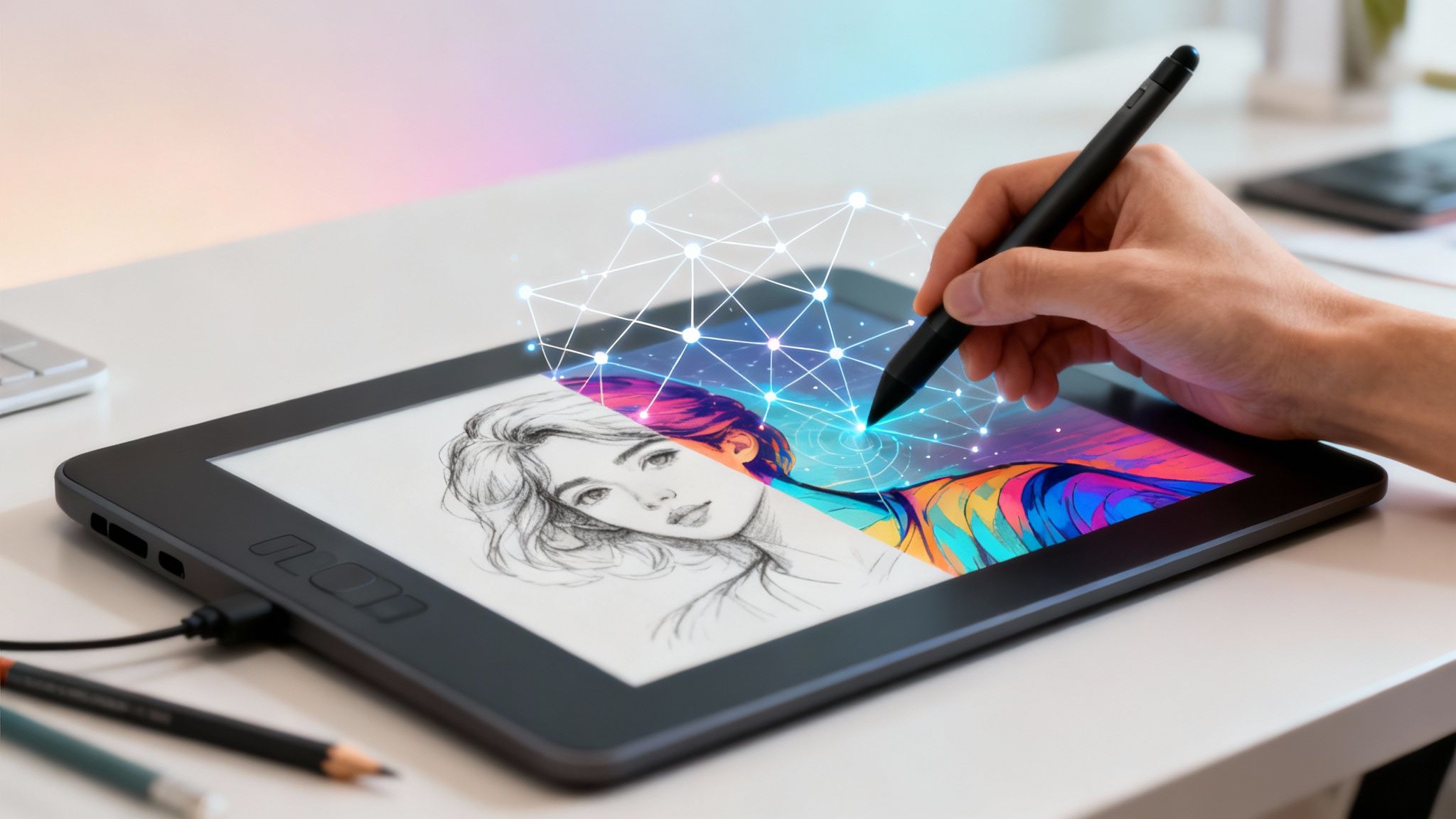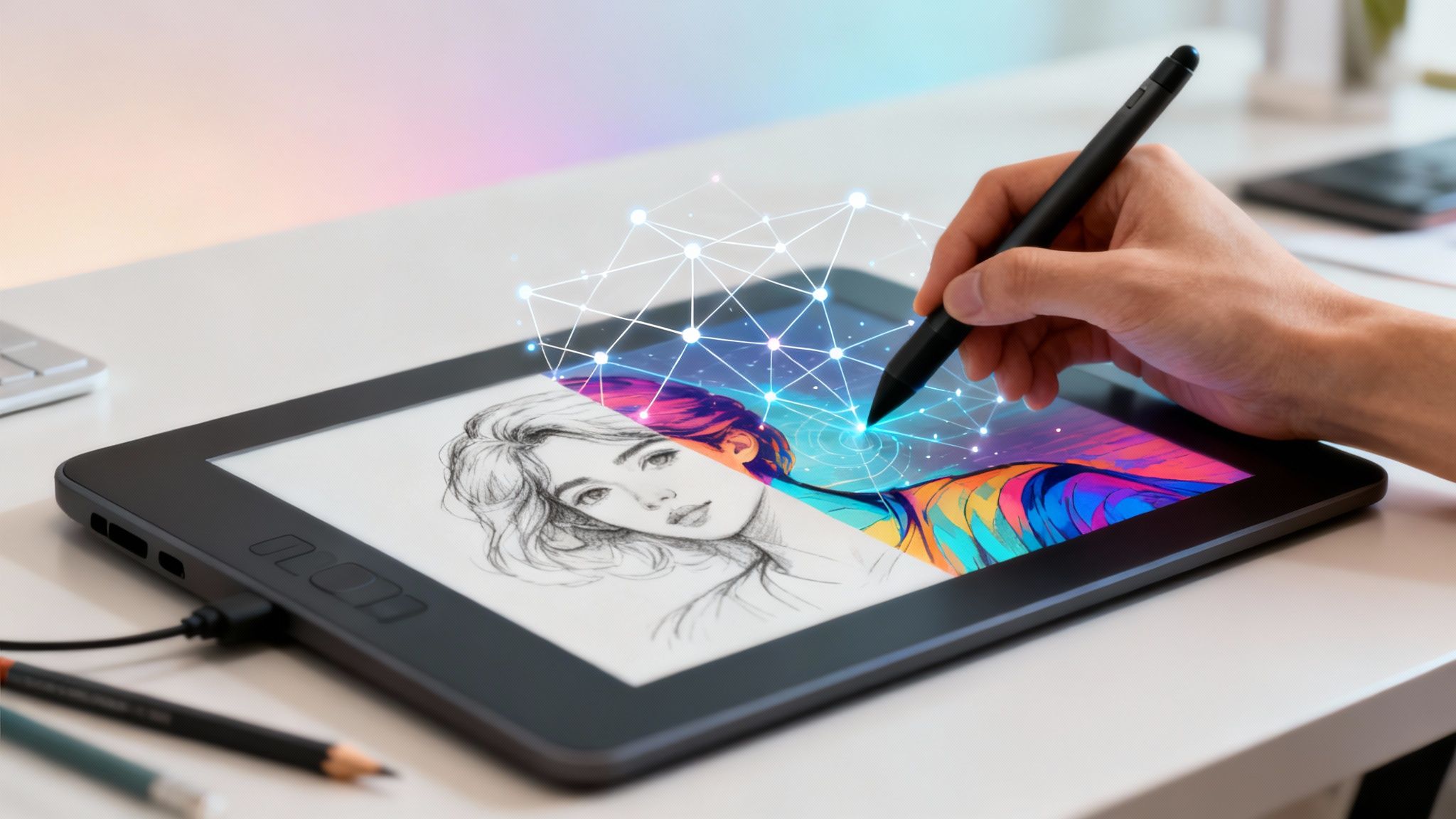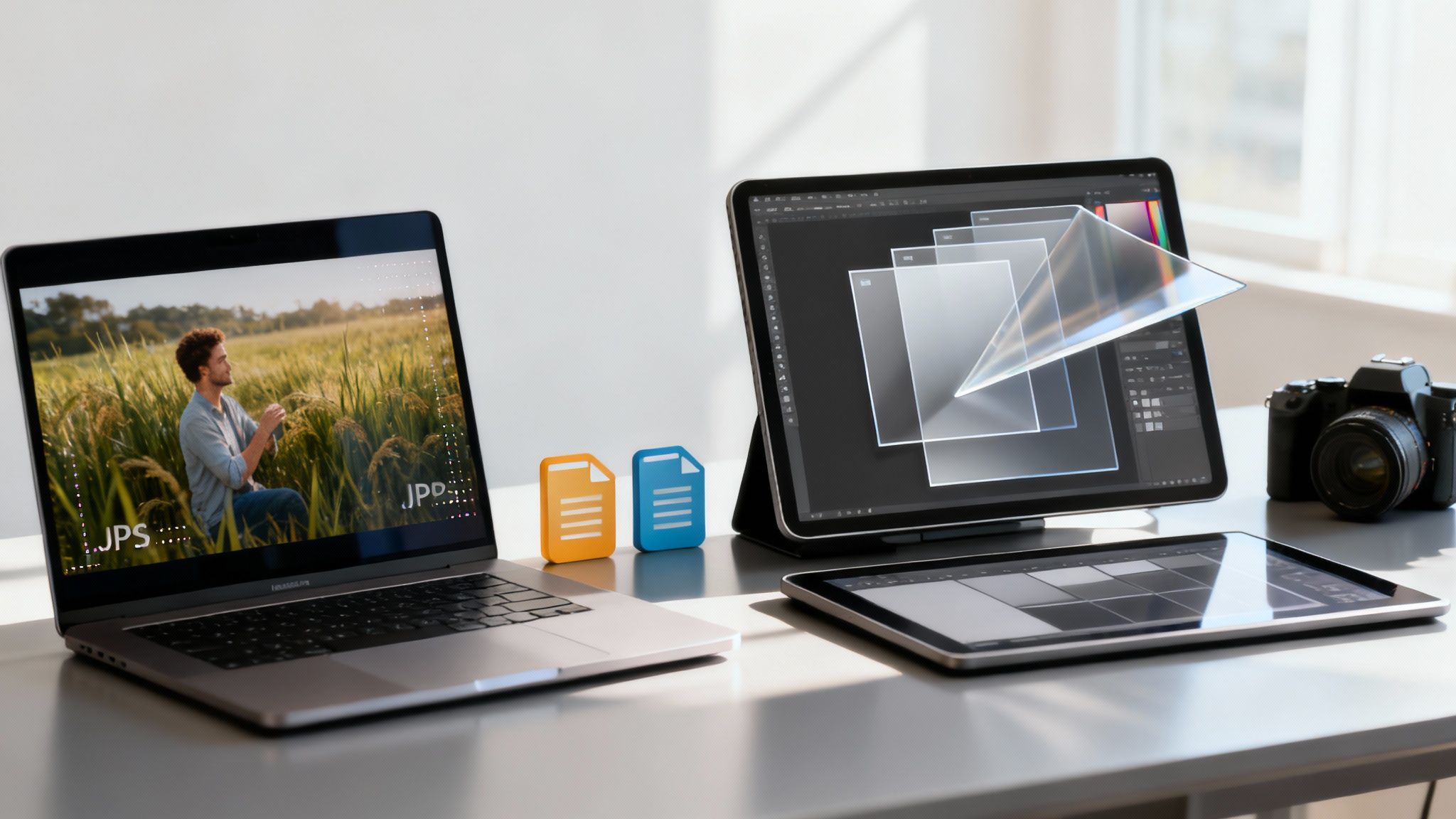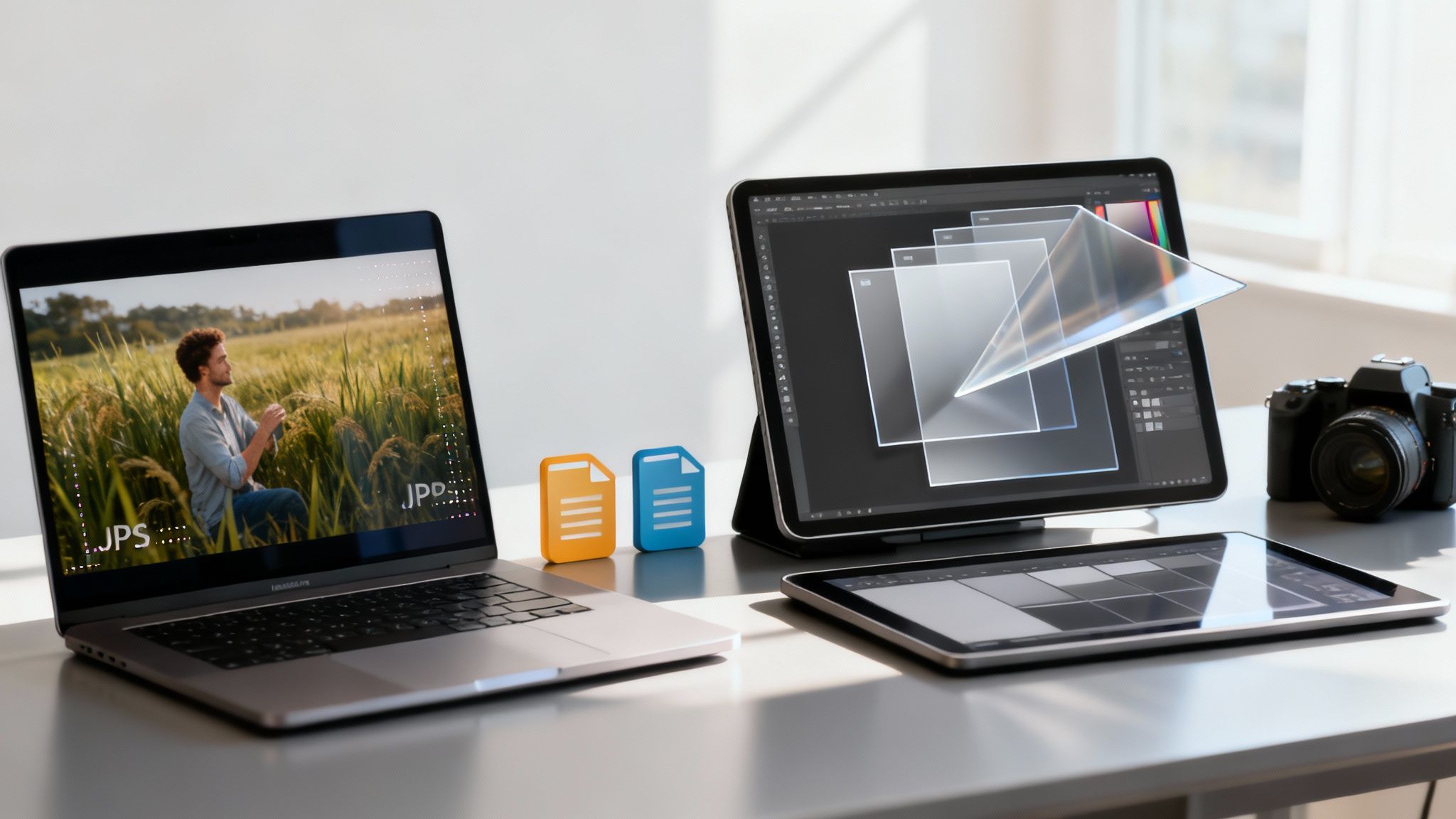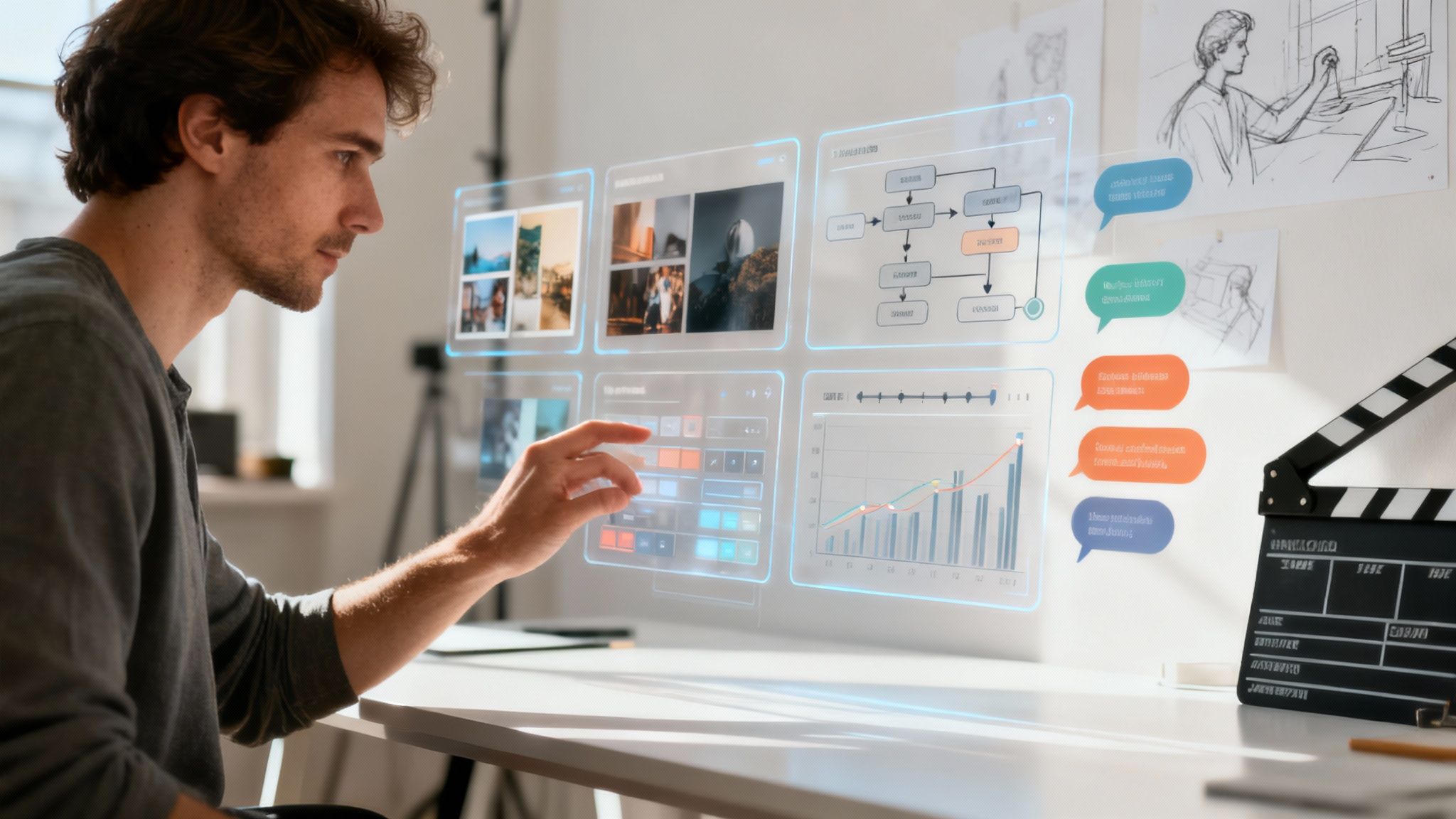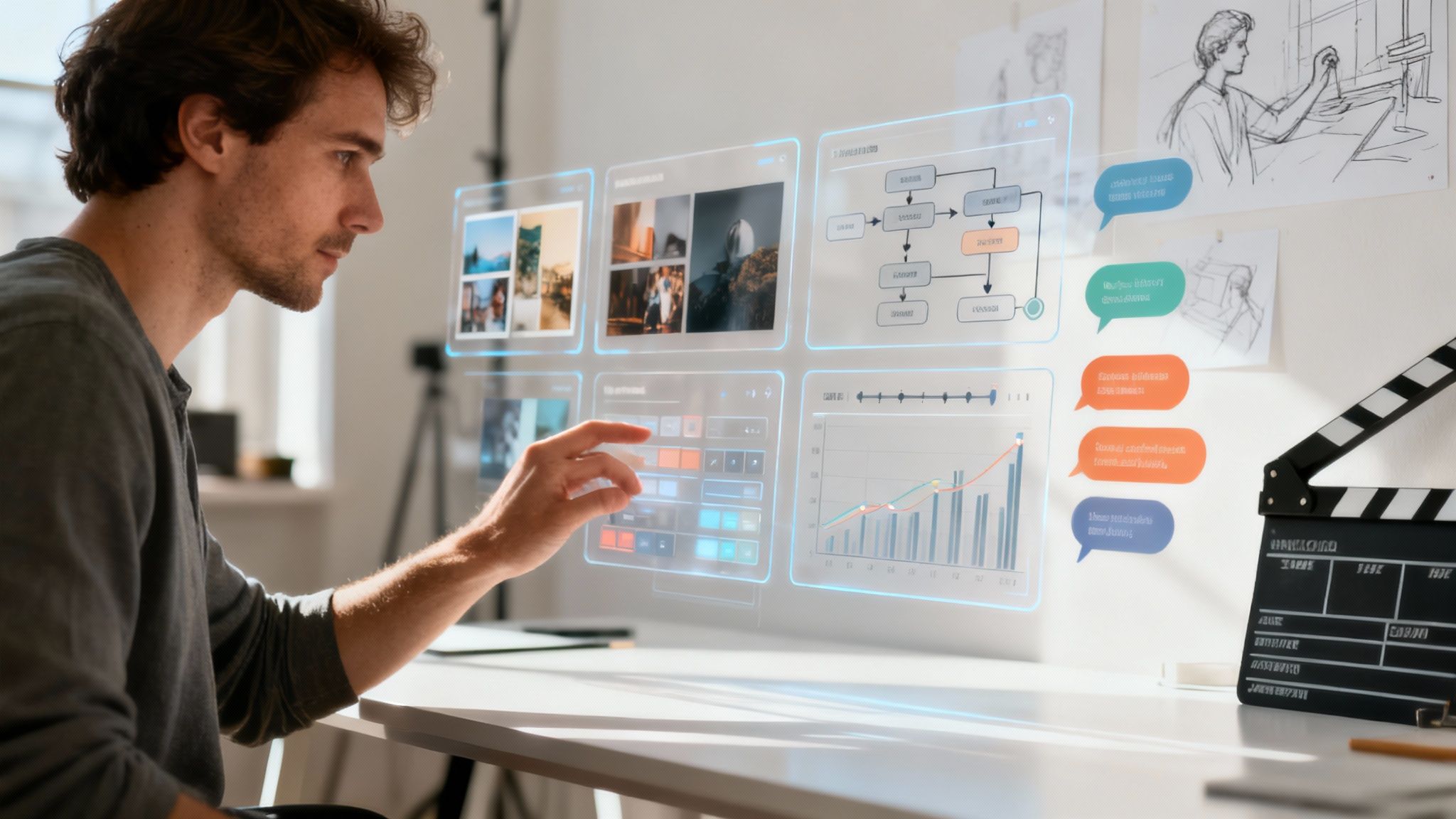Imagine turning a simple text idea into a stunning visual concept in mere seconds. This is the new reality for creative teams, thanks to artificial intelligence drawing—a technology that works more like a creative partner than a replacement for artists.
If you have not generated anything already, you can try the VirtuallPRO Creative AI OS for free. It’s a responsible, compliant, and safe enterprise platform designed for professional visual creative work.
A New Partner in Your Creative Process
The talk around AI drawing often gets stuck at two extremes: either it’s a magic button that makes artists obsolete, or it’s a complex tool only for tech experts. The truth is far more practical.
For professionals in film, gaming, and marketing, AI isn't the final product. It’s the starting point—a powerful accelerator for the human imagination.
Think of it as the ultimate creative assistant. It can spit out hundreds of visual ideas from a single brief, letting art directors and concept artists explore directions that would have taken days or weeks. This is where AI delivers real value: by handling the heavy lifting of early ideation, it frees up your best talent to focus on what matters—refinement, strategy, and storytelling.
Expanding Creative Horizons
This technology completely changes the economics of creative experimentation. When the time and cost to generate initial concepts drop to almost zero, your team is free to take bigger creative risks.
- Accelerated Ideation: Go from a written brief to a visual mood board in minutes. This means faster feedback loops with clients and stakeholders.
- Diverse Visual Exploration: Test countless variations of a character, environment, or product shot with tiny tweaks to style, lighting, and composition.
- Unblocking Creativity: Stuck? Use AI-generated images as a jumping-off point to spark new, unexpected ideas for your projects.
The growth in this space isn't happening in a vacuum. It’s part of a massive global trend. In countries like Denmark, the AI sector is booming, with a market valued at around US$3.61 billion. This growth is fueled by the rapid adoption of the very generative AI that powers artificial intelligence drawing. As these tools get woven into professional workflows, their strategic importance just keeps growing. You can learn more about Denmark's role in the AI market here.
At its core, artificial intelligence drawing is about augmenting human creativity. It takes on the repetitive, time-sucking parts of visual exploration, giving artists more room to apply their unique skills, taste, and critical eye to the final piece.
Once you demystify the tech, you see its true potential. It’s not about automating jobs away; it’s about gaining a strategic edge. It lets your team explore more, iterate faster, and deliver higher-quality visual work that connects with audiences and hits tough production deadlines.
Let’s dig into how this new partnership actually works.
How AI Actually Learns to Draw
Ever wonder what’s happening behind the scenes when you feed a prompt to a machine and get art back? It’s not magic, but a mind-bogglingly fast process of learning, trial, and error. An AI doesn't ‘understand’ a cat the way we do. Instead, it has analysed millions of cat images to pinpoint the patterns, textures, and shapes linked to that word.
Simply put, the AI learns a complex visual language. It connects text descriptions to pixels, much like our brains connect the written word "apple" with the mental image of a crisp, red fruit. This lets it combine concepts in fascinating new ways, creating visuals that feel both familiar and entirely fresh.
This infographic breaks down how AI acts as a creative partner through the entire production pipeline, from initial brainstorming to final exploration.
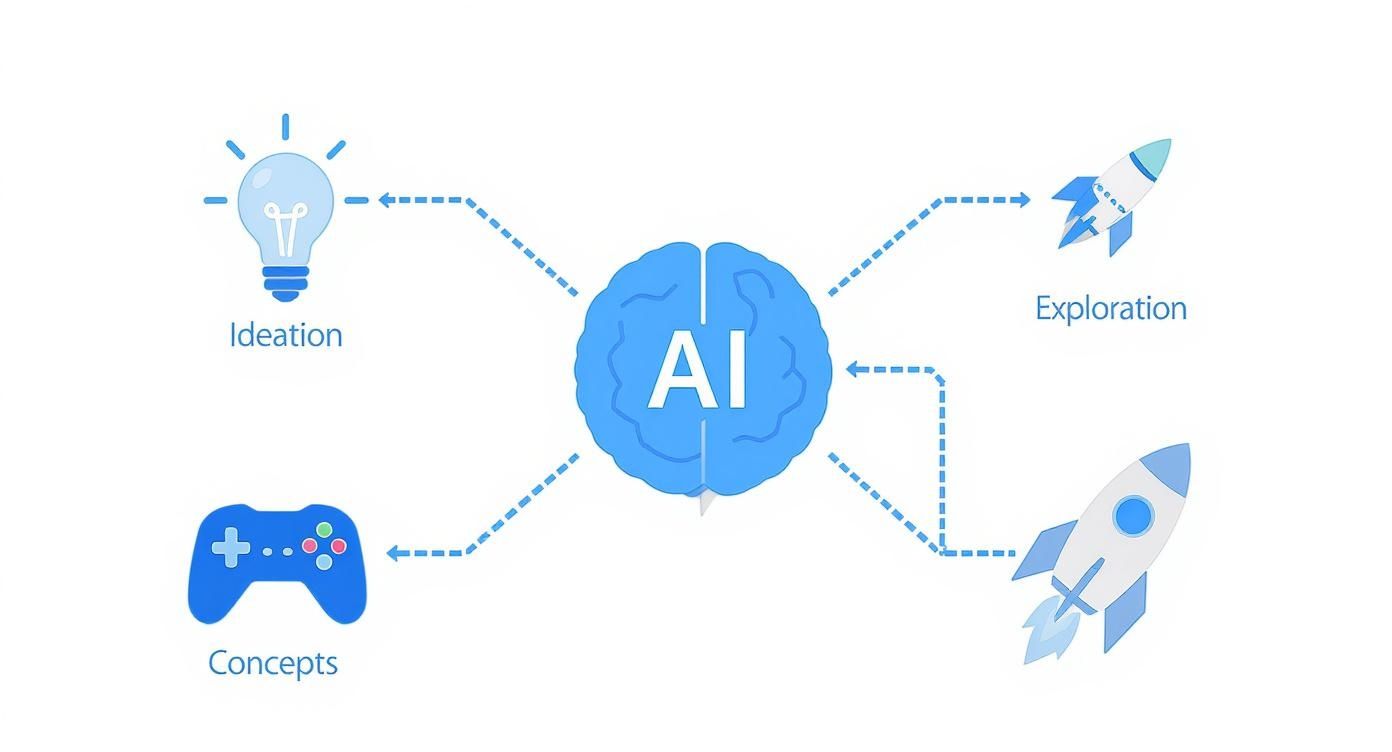
As you can see, AI becomes a catalyst at each stage, helping teams generate ideas, iterate on concepts, and explore new directions far more efficiently. Let’s dive into the core technologies that make this possible.
The Sculptor and the Static: Diffusion Models
One of the most popular methods today is the diffusion model. Think of an artist starting with a block of marble filled with random, chaotic noise—like the static on an old TV. The artist knows exactly what the finished sculpture should look like, and their job is to carefully chisel away the 'noise' until the intended form appears.
That’s a diffusion model in a nutshell. It starts with pure digital static and, guided by your text prompt, methodically reverses this noise, step by step. With each pass, the image becomes clearer, slowly emerging from the chaos until it perfectly matches your description. This process allows for incredible detail and photorealism because the AI has a highly refined method for "sculpting" pixels.
At their core, these models rely on the advanced techniques of Deep Learning, which are the foundational engines that allow them to learn from enormous datasets in the first place.
The Apprentice and the Master: Generative Adversarial Networks
Another powerful approach uses Generative Adversarial Networks, or GANs. The easiest way to get your head around GANs is to picture a driven apprentice artist and a seasoned master art critic working together.
- The Generator (The Apprentice): This part of the AI creates an image from scratch, doing its best to match the prompt. Early attempts are usually clumsy and unconvincing.
- The Discriminator (The Master Critic): This second AI has been trained on thousands of real images. Its only job is to look at the apprentice’s work and decide if it's real or fake.
These two are locked in a competitive loop. The apprentice makes an image, the critic rejects it with feedback, and the apprentice tries again, getting a little better each time. This cycle repeats millions of times until the apprentice becomes so good it can fool the master. What you get is a highly realistic and polished image.
Breathing Life into Simple Sketches
AI can do more than just generate from text; it can also bring your own drawings to life. With sketch-to-image techniques, you can upload a simple line drawing or a rough digital sketch and add a prompt describing the final style you want. The AI uses your sketch as a compositional guide, filling in the colour, texture, and detail to turn it into a fully realised piece of art.
This is a game-changer for artists who know exactly how they want an image laid out but need to explore different stylistic treatments quickly. It truly blends human intention with machine execution. To take it a step further, you can even train an AI model on your own images to create a consistent look and feel across all your generations.
Understanding these core mechanisms is the key to mastering AI drawing. When you know whether the AI is chiselling away noise or competing with itself, you gain more intuitive control over the final outcome, allowing you to guide the technology with greater precision and artistic intent.
Mastering the Language of AI Prompts
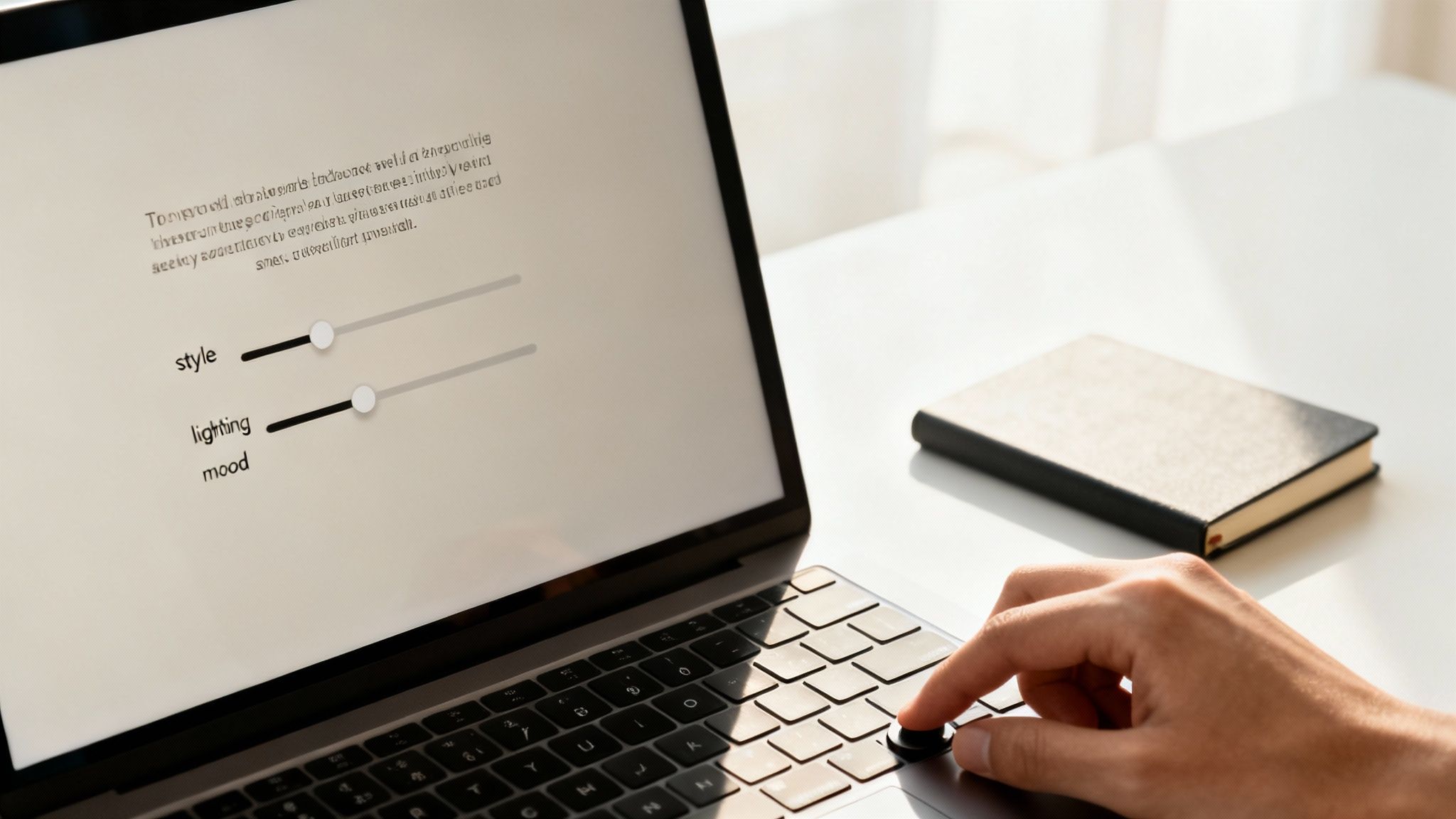
Talking to an AI drawing model isn’t like using software. It’s more like briefing a highly skilled artist who takes everything you say literally. The quality of what you get out is a direct reflection of the quality of what you put in.
A vague prompt like "a castle" gives you a generic, forgettable image. But a detailed prompt is a conversation, guiding the AI towards a specific, portfolio-worthy vision. This is where creative teams can really take control. It’s about learning to speak a new visual language.
Deconstructing a Powerful Prompt
The best prompts are built in layers, with each one adding more detail and direction. Think of it as creating a blueprint for the final image. A well-structured prompt usually combines several key ingredients to shape the result.
These are your main tools for directing the AI:
- Subject: This is the "what." Be specific. Instead of "a car," try "a vintage 1960s muscle car."
- Style and Medium: Define the artistic look. Do you want a "digital painting," "cinematic 35mm film still," "charcoal sketch," or an "art deco illustration"?
- Composition and Framing: Control how the subject is shown. Use terms like "extreme close-up," "wide-angle shot," or "from a low angle" to direct the virtual camera.
- Lighting: This is crucial for mood. Describe it with phrases like "dramatic rim lighting," "soft afternoon sun," or "neon-drenched cityscape at night."
- Mood and Atmosphere: What feeling are you aiming for? Use words like "serene," "ominous," "energetic," or "melancholy" to steer the emotional tone.
By weaving these elements together, a simple idea like "a forest" transforms into "An ancient, misty redwood forest at dawn, shafts of golden light breaking through the canopy, wide-angle shot, serene and mystical atmosphere, digital painting." Every word adds a layer of precision, leaving less to guesswork for the AI.
Fine-Tuning Your Control with Parameters
Beyond the words in your prompt, most advanced platforms offer specific parameters—think of them as the technical settings on a camera. For professional teams needing consistency, these are absolutely essential for refining your artificial intelligence drawing results.
Mastering these parameters is what separates casual experimentation from professional, predictable image generation. They give you the levers to steer the AI away from errors and replicate your most successful outcomes with precision.
Here are the most critical parameters you'll want to get familiar with:
- Negative Prompts: This is where you tell the AI what not to include. If your characters keep showing up with extra fingers, adding "mutated hands, extra limbs, poorly drawn face" to the negative prompt can clean things up fast.
- Guidance Scale (CFG): This dial controls how strictly the AI follows your prompt. A lower value gives it more creative freedom, while a higher value forces it to stick to your instructions.
- Seed Number: Every AI image starts with a random number, or "seed." If you get a result you love, grabbing its seed number lets you generate variations of that exact image later. This is a game-changer for creating a series of stylistically consistent visuals.
Learning to balance these elements is the key. For a closer look at the tools offering this level of control, check out our guide on the best AI for image generation. And to really level up your prompting skills, exploring a good ChatGPT prompts database can give you great examples and ideas. This hands-on knowledge turns the AI from a source of random images into a reliable, controllable creative partner.
Weaving AI Into Your Creative Workflow

Knowing the tech and writing good prompts is one thing. But the real challenge is plugging this powerful new tool into a live production pipeline without grinding everything to a halt. The trick is to see artificial intelligence drawing not as a replacement, but as an accelerator—especially in those messy, early, 'what if?' stages of a project.
This is where AI really shines. It can automate the high-volume, low-stakes work of initial ideation, freeing up your senior artists and directors to focus on what they do best: strategy, refinement, and nailing the final execution.
A Practical Playbook for Getting Started
You don't need to burn down your existing workflow. The smart move is to pinpoint the exact bottlenecks where AI can lend a hand and augment what your team already does brilliantly.
Here’s how different creative roles can put AI drawing to work, right now:
- For Concept Artists: Instead of spending a day on one detailed mood board, generate dozens of them. Explore a whole universe of environmental sketches in minutes. This lets you cast a much wider net for ideas at the start, making sure only the strongest concepts survive.
- For 3D Modellers: Need a unique, seamless texture for a wooden plank, a brushed metal panel, or even some weird alien skin? AI can generate endless variations, saving you the tedious hours of sourcing or building them from scratch.
- For Marketing Teams: Churn out a massive array of visuals for A/B testing ad campaigns. Tweak a few words in a prompt to test different character poses, colour palettes, or backgrounds and quickly learn what your audience actually responds to.
Double Down on the Exploratory Phase
The biggest wins come from using AI right at the front end of the creative process. This is where ideas are cheap, experimentation is encouraged, and the cost of failure is virtually zero. Dropping AI into this phase gives you the maximum creative lift with minimum risk to the final, polished work.
Think of AI as a tireless creative intern for your department. It can explore hundreds of dead ends so your senior talent doesn't have to, bringing only the most promising concepts to the table for that essential human touch.
This approach fits perfectly with modern, agile ways of working. It’s all about rapid iteration—failing faster, learning quicker, and landing on a stronger creative direction in a fraction of the time.
This efficiency is why businesses are jumping on board. In Denmark, for instance, 28% of companies are already using AI, a figure that's nearly double the EU average. The shift has been rapid, with generative AI use among Danish firms soaring from 55% to 75%. And it's paying off, with scaled pilots reporting a return on investment of around 3.7 times. It’s clear AI is becoming a core part of any competitive, modern toolkit. You can explore detailed insights on AI adoption in Denmark to see how these trends are reshaping industries.
Building a Scalable, AI-Powered Pipeline
Once your team gets the hang of it, you can make things official. For serious, enterprise-level use, a centralised platform like the VirtuallPRO Creative AI OS is a game-changer. It’s built to manage versions, share results in collaborative workspaces, and keep a tight rein on costs across all your projects.
This turns AI from a cool solo tool into a predictable, integrated part of your entire operation. It relies on a solid foundation in creative workflow management software to track every asset and every version. Get this right, and you’ll build a scalable, repeatable process that transforms creative exploration into a reliable business asset.
Navigating Copyright and Ethical Considerations
Making AI drawing a responsible part of your creative toolkit is no longer optional. As this tech becomes standard, figuring out the legal and ethical side isn't just good practice—it's essential for keeping your brand safe. The conversation gets complicated fast, moving beyond "who made this?" to questions of ownership, data, and artistic respect.
The big question for any business is copyright. Who actually owns an AI-generated image? The short answer is: it’s complicated, and the rules are still being written in courtrooms around the world. But a key principle is emerging. In most places, something created entirely by a machine can’t be copyrighted. However, your creative input—the detailed prompts, the careful curation, the post-production edits—can build a very strong case for human authorship.
The takeaway for enterprise teams is simple: your process matters. The more you can document your creative direction and the human skill that went into the final image, the stronger your claim to ownership becomes.
At Virtuall, we understand that ambiguity doesn't work for professional projects. That's why the VirtuallPRO platform is built with a clear framework for commercial use, ensuring your team can create and deploy assets with confidence within a safe and compliant enterprise environment.
Ethically Sourced Data and Attribution
Beyond copyright, the real ethical test for AI drawing is the data used to train the models. Your business needs to be sure it's using platforms trained on ethically sourced datasets—data that respects creator copyrights and has the right permissions. Using models trained on unlicensed images scraped from the internet is a huge legal and reputational risk.
This is why transparency and attribution are so important.
While AI models learn from millions of images, mimicking a living artist’s style without their permission is an ethical minefield. The responsible approach? Describe the aesthetic you want using artistic terms—"impressionistic," "art deco," "cinematic lighting"—instead of naming specific artists. This honours creators while still getting you the look you need.
This commitment to responsible development is a global priority. Denmark, for instance, has invested around 53.4 million DKK into research projects focused on developing AI that is both ethical and culturally aware. This national strategy shows a commitment to building AI that aligns with our values—a principle that's crucial for any responsible business. You can learn more about Denmark's commitment to responsible AI innovation.
Ultimately, taking a proactive stance on ethics gives you a competitive edge. It builds trust, protects your brand, and makes sure your creative work is built on a solid foundation. Here at Virtuall, we're dedicated to providing a compliant and safe Creative AI OS that lets your team innovate with total integrity.
The VirtuallPRO Creative AI OS Explained
Throughout this guide, we’ve seen what artificial intelligence drawing can do. Now, let’s talk about the operating system built to wrangle it for professional teams.
If you haven't generated anything yet, you can try VirtuallPRO for free and see for yourself what we're talking about.
Most standalone AI tools are fantastic for solo experiments, but they start to show their cracks when you try to scale them across a team. Creative production isn't just about hitting the ‘generate’ button. It’s about version control, team feedback, keeping an eye on the budget, and making sure everything stays compliant.
The VirtuallPRO Creative AI OS was built from the ground up to solve those exact problems. It pulls the entire creative lifecycle into a single, secure workspace, turning what’s often a fragmented mess into a smooth, manageable workflow.
A Unified Workspace for Creative Teams
Think of VirtuallPRO as the central hub for all your AI-powered creative work. Instead of jumping between different platforms for image generation, 3D modelling, and video, our OS brings multiple leading AI engines together in one place.
This creates a seamless flow. An idea can start as a 2D concept sketch and evolve into a finished 3D asset, all without ever leaving the platform.
A few key features make this possible:
- Robust Versioning: Every creative path and tweak is tracked automatically. This puts an end to the "which file is the final one?" headache and lets your team jump back to any previous point in the process.
- Collaborative Workspaces: These are shared environments where everyone from the art director to a junior artist can generate, review, and mark up assets in real time. It keeps the whole team on the same page.
- Prompt Blueprints: Found a prompt and a set of parameters that delivered the perfect result? Save it as a template. This is how you ensure brand consistency and let your team reproduce high-quality, on-brand assets again and again.
VirtuallPRO isn't just a collection of tools; it's an operating system designed to bring order, control, and scalability to the exciting but often chaotic world of generative AI.
Enterprise-Ready Governance and Control
For any serious business, adopting AI responsibly isn't optional. Our platform gives you the governance and control you need to deploy it at an enterprise scale.
With a unified token system, you can track usage, manage costs, and assign resources across different projects and teams with total clarity.
We’re also committed to safety and compliance, making VirtuallPRO a trusted partner for businesses that want to innovate without taking unnecessary risks. By centralising generation and asset management, you ensure your team is working within your ethical guidelines and that you maintain full control over your intellectual property.
It’s the ideal solution for studios ready to integrate artificial intelligence drawing into their core production pipelines with confidence.
Common Questions About AI Drawing
Like any new creative tool, artificial intelligence drawing comes with a lot of questions. We hear them all the time from creative teams, and getting straight answers is the first step to using these tools well. Let's tackle some of the most common ones.
Who Actually Owns AI-Generated Drawings?
This is the big one, especially for any commercial work. The legal side of things is still solidifying, but the general rule of thumb is this: if an image is 100% AI-generated with zero creative input, it likely can't be copyrighted.
But that’s rarely how it works in a professional setting. The real key is human authorship. Your detailed prompts, your back-and-forth refinements, the images you select, and any final edits you make in post-production—all of that builds a case for your creative ownership.
For businesses, the safest bet is working with a platform like VirtuallPRO that offers clear commercial usage rights. That way, your team can create and deploy assets without getting bogged down in legal grey areas.
Can AI Copy a Specific Artist's Style?
Technically, yes. Ethically and legally? It's a minefield. Prompting an AI to mimic a living artist by name is a practice that can infringe on their intellectual property and, frankly, hurts their ability to make a living. It’s a line that professional teams just shouldn't cross.
The better, more creative approach is to describe the feeling or aesthetic you’re after. Think like an art director, not a search engine.
- Instead of an artist’s name, use terms like “impressionistic brushstrokes,” “art deco geometry,” or “cyberpunk neon lighting.”
- Describe the mood you want, like “serene and minimalist” or “dark and foreboding.”
- You can also reference historical art movements or even camera specs to steer the AI in the right direction.
This method respects artists while giving you precise control over the final image. It’s about being inspired by a style, not just replicating a person's work.
How Do We Keep Our Brand Consistent with AI?
This is a totally valid concern. When anyone can generate anything, how do you maintain a cohesive brand identity? The good news is, with a little planning, it’s entirely possible.
First, create a style guide just for your AI prompts. This should outline core keywords, your brand's specific colour palettes (with hex codes), and compositional rules that define your visual language.
Next, get technical with it. When you get an image that’s perfectly on-brand, grab its seed number. You can then use that seed to generate a whole series of images with a similar stylistic DNA, ensuring everything feels connected across a campaign.
This is exactly the kind of problem enterprise platforms are built to solve. In the VirtuallPRO Creative AI OS, for instance, teams can save style presets and manage all their brand assets in one shared workspace. It ensures everyone, from the junior designer to the marketing lead, is creating on-brand content, every single time.
Ready to bring artificial intelligence drawing into your creative workflow with confidence and control? Explore the VirtuallPRO Creative AI OS and discover how our enterprise-ready platform provides the tools for seamless generation, versioning, collaboration, and cost management. Start your free trial today.

